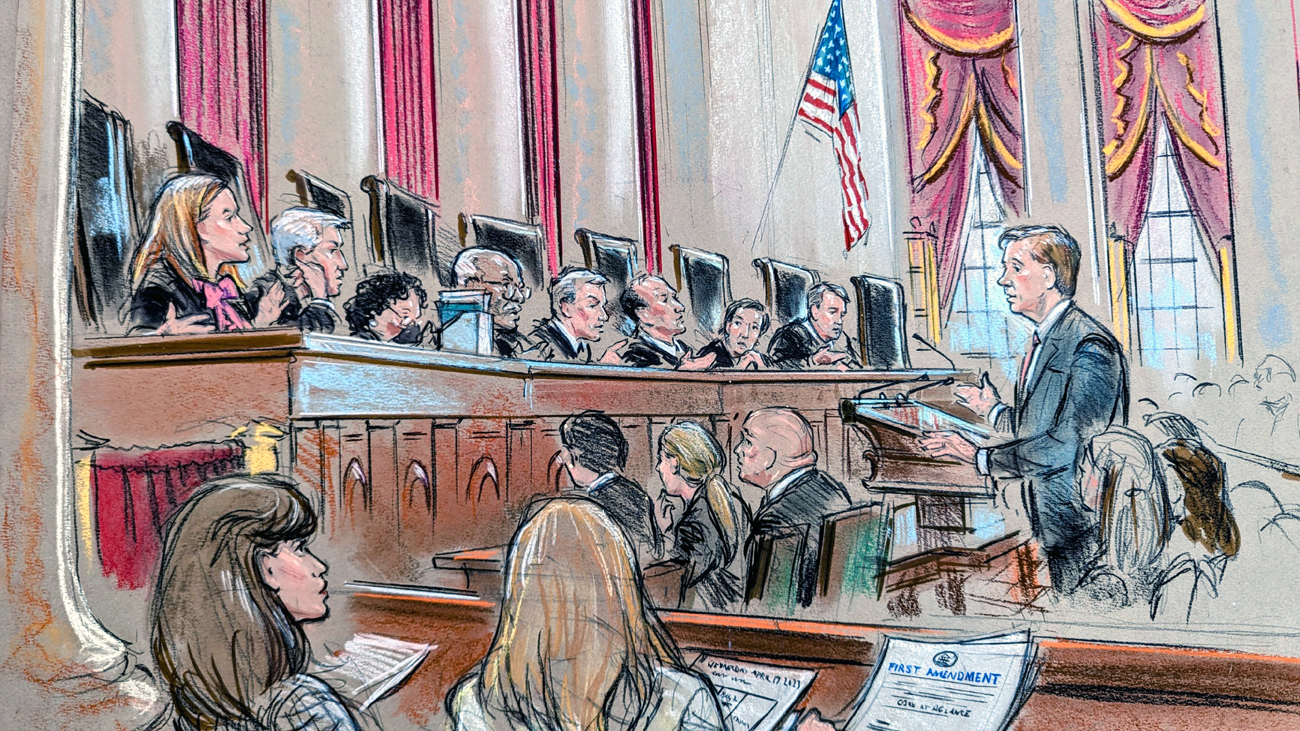ARGUMENT ANALYSIS
on Apr 20, 2023
at 3:24 pm

John Elwood arguing for Billy Raymond Counterman. (William Hennessy)
The Supreme Court heard oral argument on Wednesday in the case of a Colorado man who was sentenced to four-and-a-half years in prison for stalking based on the Facebook messages that he sent to  local musician Coles Whalen. At issue in the case is how courts should determine what constitutes “true threats,†which are not protected by the First Amendment. At the end of nearly two hours of debate, the justices generally appeared skeptical of Colorado’s contention that courts should use an objective test, that looks at whether a reasonable person would regard the statement as a threat of violence. But it wasn’t entirely clear what test the justices might adopt in its place.
Representing Billy Raymond Counterman, John Elwood urged the justices to eschew the objective test on which the state courts relied to convict his client. He emphasized the negative effects that would flow from such a test, noting that “[c]riminalizing misunderstanding is especially dangerous in an age when so much communication occurs on social media, which brings together strangers in an environment that removes much of the context that gives words meaning.†The objective test, Elwood added, would also chill even legal speech, because speakers will not want to risk prison time if their speech is perceived as a threat.
Colorado Attorney General Philip Weiser countered that adopting Counterman’s subjective intent standard would “enable more harm and less valuable discourse,†because “a serious expression of an intent to cause unlawful physical violence directly causes life-changing harm and does not contribute to the marketplace of ideas.†In particular, Weiser stressed, “requiring specific intent in cases of threatening stalkers “would immunize stalkers who are untethered from reality†and “allow devious stalkers to escape accountability by insisting that they meant nothing by their harmful statements.†“This matters,†Weiser continued, because “threats made by stalkers terrorize victims.â€

Colorado Attorney General Philip Weiser arguing for the state. (William Hennessy)
Describing the various references to the speaker’s intent as “confusing,†Justice Samuel Alito tried to clarify exactly what rule Elwood was proposing.
Elwood responded that, under his rule, a speaker could be convicted if he had “knowledge of the thing that makes the conduct wrongful. In most threat statutes, that’s knowledge that the words you use are going to cause fear.†For the Colorado stalking law at issue in this case, Elwood said, “it would be knowledge that it would cause a reasonable person to suffer emotional distress.â€
Alito suggested that a different standard, more stringent than Colorado’s but a lower bar than Counterman’s, might be appropriate instead. Why shouldn’t the test be whether the speaker’s conduct was reckless – that is, he was aware that others could regard his speech as a threat, but he made the statements anyway? “Reckless conduct,†Alito said, “is morally culpable, and a threat causes damage regardless of the intent of the speaker.â€
Elwood allowed that a recklessness standard “would be a big improvement over a[n] objective standard†because it focuses on the speaker and his mental state and is therefore less likely to chill speech than a purely objective standard. But there is no tradition in U.S. law of regulating threats based on recklessness, Elwood stressed.
Justice Brett Kavanaugh also seemed amenable to a recklessness standard. He told Weiser that it “seems to capture some of the concerns you’ve heard while leaving plenty of room, one would hope, to make sure threats are captured before someone is killed or physically hurt.â€
Justice Sonia Sotomayor was sympathetic to Counterman, but she seemed less inclined to adopt a recklessness standard. For her, the question before the justices was an even narrower one. Although Alito agrees that the jury should hear evidence about the speaker’s intent in cases involving the First Amendment, she said, in this case Counterman couldn’t present any evidence of his intent. Therefore, she said, the only question before the court is whether it should approve a test that “doesn’t take into account any of the intentions of the speaker when we prosecute for speech.â€
Only the federal government, which filed a “friend of the court†brief supporting Colorado, has suggested the recklessness standard as a middle ground, Sotomayor noted – which is not enough for the Supreme Court to decide the case on that ground.

Deputy Solicitor General Eric Feigin representing the government. (William Hennessy)
Justice Elena Kagan was more skeptical of Counterman’s argument. In other areas involving free speech, such as libel of public figures and incitement, the court has provided some leeway because it believes that there is a very thin line between speech that has “great value†and speech that has no value. But in this case, she continued, what kind of speech would be chilled if the court were to adopt the objective intent test? What speech, she said, comes close to being a “true threat†but is so “supervaluable†that we need to be worried about it?
Chief Justice John Roberts worried aloud that adopting Counterman’s rule would make it harder for victims of domestic violence, for example, to obtain civil protection orders, which often require proof of a crime.
On the other hand, despite Weiser’s assurances that the objective standard is a high one that would weed out misunderstandings, Roberts was dubious. He cited one of the statements for which Counterman was convicted, in which he told Whalen that “staying in cyberlife is going to kill you. Come out for coffee.† “In what way is that threatening,†Roberts asked, “regardless of the tone? What tone would you use that would make it threatening?â€
Weiser responded that the statement was threatening when put into context. But that led to pushback from Justice Neil Gorsuch, who asked why the speaker’s intentions wouldn’t be part of the context. Weiser explained that a defendant’s subjective belief about the effect of his speech wasn’t relevant “because it doesn’t get to the nature of the harm. Statements can be objectively terrorizing to somebody†even if the speaker says he didn’t intend for them to be.
Gorsuch then expressed concern that holding someone criminally liable based on an objective test was especially problematic because people have become “increasingly sensitive.â€
Justice Clarence Thomas was also troubled by this idea. He told Weiser that “we’re more hypersensitive about different things now, and people could feel threatened in different ways.†Some of the statements that Roberts had pointed to, Thomas said, “are not threatening and of themselves, and yet someone could be triggered by those statements or hypersensitive about those statements and feel threatened.â€
Justice Amy Coney Barrett had a related concern. Who, she asked “is the reasonable person?†She outlined a hypothetical involving a college classroom in which a professor, for “purely educational†reasons, “puts up a picture of a burning cross and reads aloud some threats of lynching that were made at the time.†“Maybe it’s the case,†Barrett suggested, “that nowadays people would be more sensitive to that and … a reasonable Black college student sitting in that classroom would interpret that as threats … that might materialize into actual physical harm.â€
Representing the federal government, Deputy Solicitor General Eric Feigin cautioned that a focus on the defendant’s specific intent makes it much harder for prosecutors to arrest and bring charges. “They have to wait a lot longer for the objective evidence to build up,†Feigin stressed.
Elwood pushed back in his rebuttal, reminding the justices that over 20 states use a subjective intent test, with others using a recklessness standard. But there is no indication, he emphasized, that those standards have caused any problems in practice.
A decision in the case is expected by summer.
This article was originally published at Howe on the Court.





